The Gartenmeister Bonstedt
Saturday, April 08, 2023
I distinctly remember the first time I came across Fuchsia ‘Gartenmeister Bonstedt’. It was at a rather large, and I thought at the time, what a rather nice nursery. I was still mostly a teenager then.
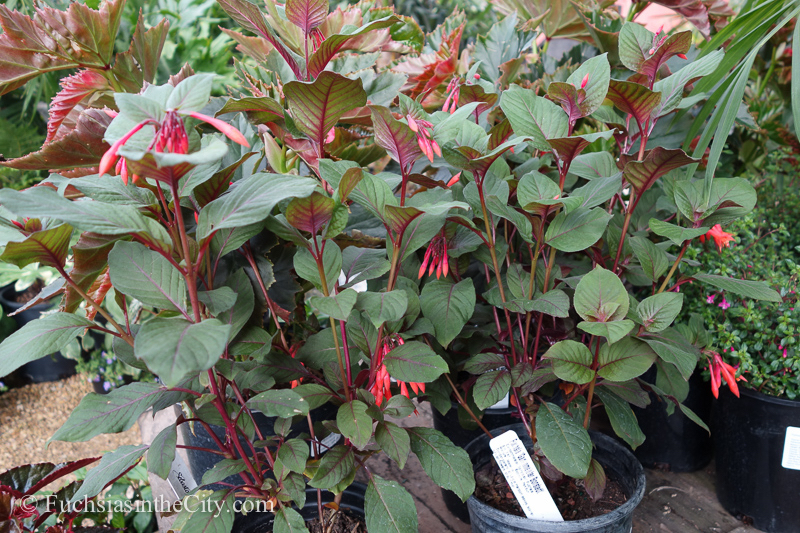
Fuchsias I already knew. But they were mostly the pop-able kind. You know, the ones from your grandparent’s garden. Those tempting round-buds you squeezed just so slightly as a kid for that satisfying thrill of a little >POP<. Sort of like an early form of bubble wrap if you’ve ever gone around popping fuchsias. Only natural and infinitely better, of course.
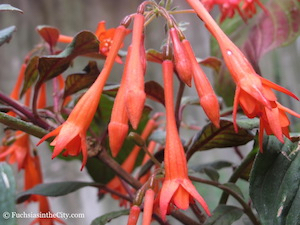 Just what was this brilliant trumpet-like oddity, I wondered? Fuchsias! I was suddenly smitten by the long, elegant blossoms (popable or not) and the very un-fuchsia-red fuchsia-orange color. And completely enthralled by the fact it was so unabashedly upright and actually reveled in a lot more sunshine than fuchsias usually do. I wanted them. I wanted them all.
Just what was this brilliant trumpet-like oddity, I wondered? Fuchsias! I was suddenly smitten by the long, elegant blossoms (popable or not) and the very un-fuchsia-red fuchsia-orange color. And completely enthralled by the fact it was so unabashedly upright and actually reveled in a lot more sunshine than fuchsias usually do. I wanted them. I wanted them all.
But I looked into my teenage wallet. Sad thing, as I recall. Almost empty. It struck me that if this was a fuchsia, it should act like a fuchsia. I settled for one and immediately set about creating that all-of-them from cuttings. I may have been a teenager with a teenage wallet, but I was always a teenager with a green thumb.
By a couple of weeks, or three, I had created enough ‘Gartenmeister Bonstedt’ to happily tuck it in all over the place. If I remember right, a couple of dozen plants eventually came out of it. I still look back at that “Summer of My Triphyllas” fondly.
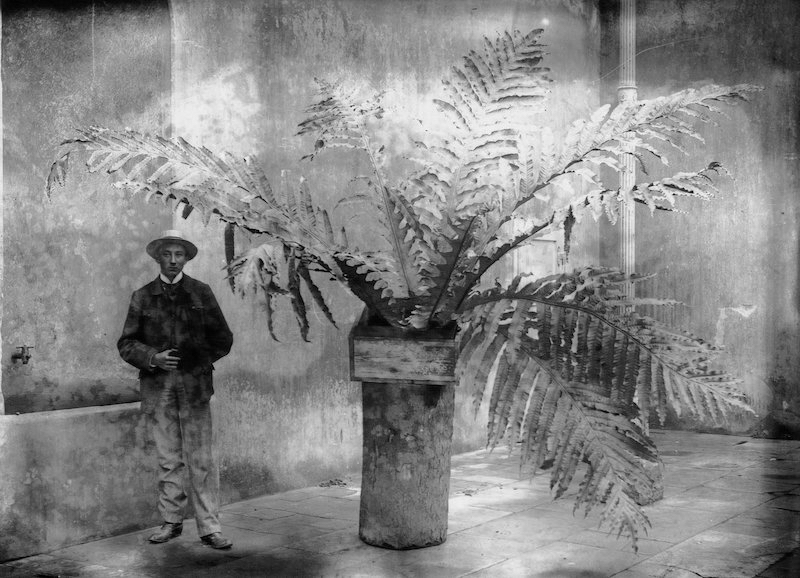
Who was this Master of the Garden named Bonstedt, though? A beautiful hybrid, but what an odd name. Was the name even real? It turned out that he most certainly was real. Carl Bonstedt, in fact, was a celebrated German botanist, gardener, and prolific hybridizer of plants.
In fuchsias, he worked primarily with Fuchsia triphylla in crosses with Fuchsia fulgens. Bonstedt worked with an amazing array of other plants, including caladiums, calla lilies, lilies, nepenthes, primulas and even the carnivorous pitcher plants, the sarracenias. For all his services to horticulture, the barberry-family genus Bonstedtia was named in his honor.
 Born in 1866 in Naumburg an der Saale, Carl Bonstedt received his earliest training at the Pomologische Institut in Proskau (now Prószków, Poland). Yes, that is an Apple Institute. But the term does cover other garden fruit trees as well. Bonstedt then spent a number of years working at the Royal Botanical Gardens at Kew.
Born in 1866 in Naumburg an der Saale, Carl Bonstedt received his earliest training at the Pomologische Institut in Proskau (now Prószków, Poland). Yes, that is an Apple Institute. But the term does cover other garden fruit trees as well. Bonstedt then spent a number of years working at the Royal Botanical Gardens at Kew.
It was at Kew that Bonstedt might have developed his life-long affinity for Fuchsia triphylla. In 1873, seeds of that long-lost fuchsia went from Santo Domingo or Haiti to the New York nurseryman, Thomas Hogg, Jr. By some accounts, Hogg is credited with collecting the seeds himself on a visit to Hispaniola. In others, he seems to have been just the recipient of the seeds. However he came about them, Hogg successfully propagated the plants and offered them for sale at his celebrated nursery in the upper Manhattan countryside. (Yes, there was such a thing in those days.)
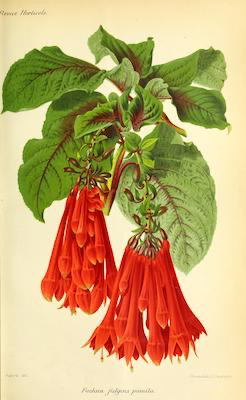 Some seeds seem to have found their way to England as Fuchsia racemosa but it was the New York Botanical Garden that sent Hogg’s mysterious fuchsia to Kew in 1882 for a thorough examination and its subsequent identification as F. triphylla. The appearance of a color illustration in The Garden magazine in 1892 would cause quite a flurry of excitement and interest in the species throughout Europe.
Some seeds seem to have found their way to England as Fuchsia racemosa but it was the New York Botanical Garden that sent Hogg’s mysterious fuchsia to Kew in 1882 for a thorough examination and its subsequent identification as F. triphylla. The appearance of a color illustration in The Garden magazine in 1892 would cause quite a flurry of excitement and interest in the species throughout Europe.
Meanwhile, back again in Germany, Bonstedt become director of the Botanical Gardens in Rostock on the Baltic coast from 1892-1900. In 1900, Bonstedt’s horticultural career took a major and a significant advance. He was appointed Inspektor des Gartens (Technical Director) of the historic and celebrated Botanical Gardens—the Old Garden was establish in 1736—at the University of Göttingen in Lower Saxony
Besides his normal duties in the garden, Bonstedt taught and lectured on horticulture at the University in Göttingen and at the then Deutsche Kolonialschule für Landwirtschaft, Handel und Gewerbe (German Colonial School for Agriculture, Trade and Industry) in nearby Witzenhausen. The Alpine Garden was established under his leadership, as well, and he became widely known for his cultivation of tropical ferns, orchids, and epiphytes. In horticulture, Bonstedt developed numerous new varieties of the afore-mentioned primulas, lilies, callas, caladiums, sarracenias, nepenthes and, of course, those fuchsias.
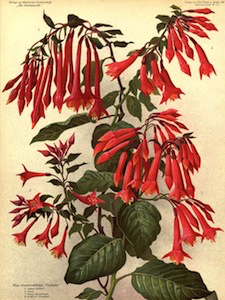 It was here at Göttingen that Bonstedt was to produce almost all of his distinctive and still widely grown Fuchsia triphylla hybrids. He had already created the intensely red-flowered ‘Mary’ while at Rostock in 1897. This, his earliest cross of F. triphylla with F. corymbiflora, is beautiful but somewhat delicate to grow and not very sun-tolerant. Bonstedt also attempted pollinating F. corymbiflora with F. triphylla but that reverse endeavor would prove disappointing and fruitless as none of the progeny flowered. At Göttingen, Bonstedt switched to using F. fulgens. The results would prove far superior and produced the exceptional plants for which he is still justly famous.
It was here at Göttingen that Bonstedt was to produce almost all of his distinctive and still widely grown Fuchsia triphylla hybrids. He had already created the intensely red-flowered ‘Mary’ while at Rostock in 1897. This, his earliest cross of F. triphylla with F. corymbiflora, is beautiful but somewhat delicate to grow and not very sun-tolerant. Bonstedt also attempted pollinating F. corymbiflora with F. triphylla but that reverse endeavor would prove disappointing and fruitless as none of the progeny flowered. At Göttingen, Bonstedt switched to using F. fulgens. The results would prove far superior and produced the exceptional plants for which he is still justly famous.
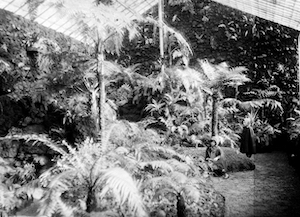 The crosses include such favorites as 'Bornemans Beste' (1904), the eponymous ‘Gartenmeister Bonstedt' (1905), 'Göttingen' (1905), ‘Coralle' a.k.a. ‘Koralle’ (1905), 'Thalia' (1905), 'Träudchen Bonstedt' (1905), and a number of others. Bonstedt's earliest fuchsias are sometimes incorrectly attributed to nurseryman and "florist" Georg Bornemann, as they were introduced to an eager gardening public through Bornemann’s famous nursery in Blankenburg am Harz, Germany.
The crosses include such favorites as 'Bornemans Beste' (1904), the eponymous ‘Gartenmeister Bonstedt' (1905), 'Göttingen' (1905), ‘Coralle' a.k.a. ‘Koralle’ (1905), 'Thalia' (1905), 'Träudchen Bonstedt' (1905), and a number of others. Bonstedt's earliest fuchsias are sometimes incorrectly attributed to nurseryman and "florist" Georg Bornemann, as they were introduced to an eager gardening public through Bornemann’s famous nursery in Blankenburg am Harz, Germany.
The gardens experienced an especial flowering under Bonstedt and he remained at Göttingen until his retirement in 1931. Even after he withdrew into private life, Bonstedt continued to write and lecture widely. He was the author of professional texts such as Schnittblumen: Handbuch für den Praxis des Schnittblumenbaues (1937), as well as the editor of the popular reference work, Pareys Blumengärtnerei. He died in 1953 at the age of 86.
 ’Gartenmeister Bonstedt’ has beautiful dark velvety green, bronze-red tinted foliage with attractive purple-red veins carried on vigorously upright growth. The undersides of the leaves and the stems are again a lovely purple-red. Its flowers are brick-red to orange-red, depending on the intensity of the light, and carried in terminal clusters. It’s very similar to ‘Thalia’, with which it’s often confused. So confused are the two that you’re probably just as likely to find ‘Thalia’ labelled as ‘Gartenmeister Bonstedt’ or vice versa.
’Gartenmeister Bonstedt’ has beautiful dark velvety green, bronze-red tinted foliage with attractive purple-red veins carried on vigorously upright growth. The undersides of the leaves and the stems are again a lovely purple-red. Its flowers are brick-red to orange-red, depending on the intensity of the light, and carried in terminal clusters. It’s very similar to ‘Thalia’, with which it’s often confused. So confused are the two that you’re probably just as likely to find ‘Thalia’ labelled as ‘Gartenmeister Bonstedt’ or vice versa.
‘Gartenmeister Bonstedt’ has a more pronounced bulbous end to the flower tubes, like its parent F. triphylla, while ’Thalia’s’ tube is a bit straighter. Another subtle difference, more pronounced and apparent when the two cultivars are grown side by side, is that the foliage on ’Thalia’ is more olive green with magenta veining and purple undersides.
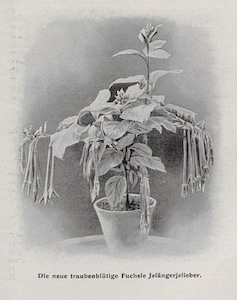 ‘Gartenmeister Bonstedt’ tolerates a more sun than most other fuchsias. In some climates, that can mean full sun all day long. In others, it certainly appreciates protection from the full force of that sun, especially in the heat of the afternoon. It should also be grown a tad drier. That’s good for exposed planters, or spots around the garden that are hotter and drier than other fuchsias like. However, neither sunnier nor drier means that it’s a cactus. Or even a geranium. I’ve seen too many of the poor things plopped into the edge of a parking lot, looking like they would make a desperate run for the trees if they only could.
‘Gartenmeister Bonstedt’ tolerates a more sun than most other fuchsias. In some climates, that can mean full sun all day long. In others, it certainly appreciates protection from the full force of that sun, especially in the heat of the afternoon. It should also be grown a tad drier. That’s good for exposed planters, or spots around the garden that are hotter and drier than other fuchsias like. However, neither sunnier nor drier means that it’s a cactus. Or even a geranium. I’ve seen too many of the poor things plopped into the edge of a parking lot, looking like they would make a desperate run for the trees if they only could.
Along with most of the triphylla hybrids, ‘Gartenmeister Bonstedt; is not particularly frost hardy. If it’s potted, take it in to shelter before the first frost. It probably won’t overwinter planted out in the open ground in most cold places that fall and stay below freezing. If you do bed it out, plant it deeply, lift it in the fall, or consider this fuchsias a sacrifice to the cruel gods of winter. Otherwise, take some late-season cuttings to root inside for next year. A bright windowsill or plant lights will do if you don’t have a proper greenhouse. In a few weeks you’ll have rooted enough new ‘Gartenmeister Bonstedt’ plants to happily stick it all over the place.
Today, by the way, just happens to be Bonstedt’s 155th birthday. So go out and plant some ‘Gartenmeister Bonstedt’ in celebration.
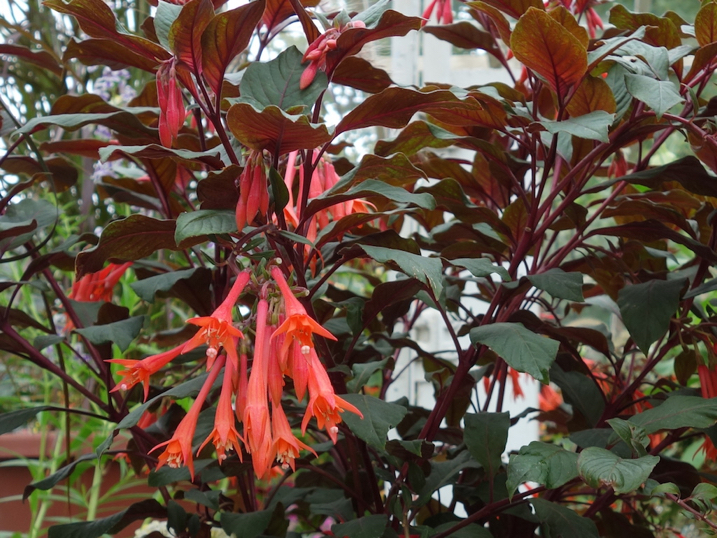
(Illustrations: 1, 2, & 10. Fuchsia 'Gartenmeister Bonstedt', 3. Portrait of Carl Bonstedt with Polypodium heracleum; 4. Fuchsia triphylla, The Garden, Vol. 41 (1892), 5. Fuchsia fulgens, Revue Horticole, Series 4. Vol. 53 (1881), 6 ‘Gartenmeister Bonstedt’s numerous relatives: Bonstedt cultivars 'August Siebert' (1905), 'Puck' (1915), 'Georg Bornemann' (1915) and 'Irmgard Bonstedt' (1915). This contemporary drawing is by the illustrator Johanna Beckmann published in Die Gartenwelt, Illustrierte Wochenschrift für den gesamten Gartenbau (1915, Volume 196), 7. Bonstedt's Fern House at the Göttingen Botanical Garden ca. 1925. 8. Fuchsia 'Traudchen Bonstedt' named for his daughter; 9. Fuchsia 'Jelängerjelieber'. The name literally means "the longer the lovelier" but this interesting plant unfortunately seems to be lost to cultivation.)

Fuchsias I already knew. But they were mostly the pop-able kind. You know, the ones from your grandparent’s garden. Those tempting round-buds you squeezed just so slightly as a kid for that satisfying thrill of a little >POP<. Sort of like an early form of bubble wrap if you’ve ever gone around popping fuchsias. Only natural and infinitely better, of course.

But I looked into my teenage wallet. Sad thing, as I recall. Almost empty. It struck me that if this was a fuchsia, it should act like a fuchsia. I settled for one and immediately set about creating that all-of-them from cuttings. I may have been a teenager with a teenage wallet, but I was always a teenager with a green thumb.
By a couple of weeks, or three, I had created enough ‘Gartenmeister Bonstedt’ to happily tuck it in all over the place. If I remember right, a couple of dozen plants eventually came out of it. I still look back at that “Summer of My Triphyllas” fondly.

Who was this Master of the Garden named Bonstedt, though? A beautiful hybrid, but what an odd name. Was the name even real? It turned out that he most certainly was real. Carl Bonstedt, in fact, was a celebrated German botanist, gardener, and prolific hybridizer of plants.
In fuchsias, he worked primarily with Fuchsia triphylla in crosses with Fuchsia fulgens. Bonstedt worked with an amazing array of other plants, including caladiums, calla lilies, lilies, nepenthes, primulas and even the carnivorous pitcher plants, the sarracenias. For all his services to horticulture, the barberry-family genus Bonstedtia was named in his honor.

It was at Kew that Bonstedt might have developed his life-long affinity for Fuchsia triphylla. In 1873, seeds of that long-lost fuchsia went from Santo Domingo or Haiti to the New York nurseryman, Thomas Hogg, Jr. By some accounts, Hogg is credited with collecting the seeds himself on a visit to Hispaniola. In others, he seems to have been just the recipient of the seeds. However he came about them, Hogg successfully propagated the plants and offered them for sale at his celebrated nursery in the upper Manhattan countryside. (Yes, there was such a thing in those days.)

Meanwhile, back again in Germany, Bonstedt become director of the Botanical Gardens in Rostock on the Baltic coast from 1892-1900. In 1900, Bonstedt’s horticultural career took a major and a significant advance. He was appointed Inspektor des Gartens (Technical Director) of the historic and celebrated Botanical Gardens—the Old Garden was establish in 1736—at the University of Göttingen in Lower Saxony
Besides his normal duties in the garden, Bonstedt taught and lectured on horticulture at the University in Göttingen and at the then Deutsche Kolonialschule für Landwirtschaft, Handel und Gewerbe (German Colonial School for Agriculture, Trade and Industry) in nearby Witzenhausen. The Alpine Garden was established under his leadership, as well, and he became widely known for his cultivation of tropical ferns, orchids, and epiphytes. In horticulture, Bonstedt developed numerous new varieties of the afore-mentioned primulas, lilies, callas, caladiums, sarracenias, nepenthes and, of course, those fuchsias.


The gardens experienced an especial flowering under Bonstedt and he remained at Göttingen until his retirement in 1931. Even after he withdrew into private life, Bonstedt continued to write and lecture widely. He was the author of professional texts such as Schnittblumen: Handbuch für den Praxis des Schnittblumenbaues (1937), as well as the editor of the popular reference work, Pareys Blumengärtnerei. He died in 1953 at the age of 86.

‘Gartenmeister Bonstedt’ has a more pronounced bulbous end to the flower tubes, like its parent F. triphylla, while ’Thalia’s’ tube is a bit straighter. Another subtle difference, more pronounced and apparent when the two cultivars are grown side by side, is that the foliage on ’Thalia’ is more olive green with magenta veining and purple undersides.

Along with most of the triphylla hybrids, ‘Gartenmeister Bonstedt; is not particularly frost hardy. If it’s potted, take it in to shelter before the first frost. It probably won’t overwinter planted out in the open ground in most cold places that fall and stay below freezing. If you do bed it out, plant it deeply, lift it in the fall, or consider this fuchsias a sacrifice to the cruel gods of winter. Otherwise, take some late-season cuttings to root inside for next year. A bright windowsill or plant lights will do if you don’t have a proper greenhouse. In a few weeks you’ll have rooted enough new ‘Gartenmeister Bonstedt’ plants to happily stick it all over the place.
Today, by the way, just happens to be Bonstedt’s 155th birthday. So go out and plant some ‘Gartenmeister Bonstedt’ in celebration.

(Illustrations: 1, 2, & 10. Fuchsia 'Gartenmeister Bonstedt', 3. Portrait of Carl Bonstedt with Polypodium heracleum; 4. Fuchsia triphylla, The Garden, Vol. 41 (1892), 5. Fuchsia fulgens, Revue Horticole, Series 4. Vol. 53 (1881), 6 ‘Gartenmeister Bonstedt’s numerous relatives: Bonstedt cultivars 'August Siebert' (1905), 'Puck' (1915), 'Georg Bornemann' (1915) and 'Irmgard Bonstedt' (1915). This contemporary drawing is by the illustrator Johanna Beckmann published in Die Gartenwelt, Illustrierte Wochenschrift für den gesamten Gartenbau (1915, Volume 196), 7. Bonstedt's Fern House at the Göttingen Botanical Garden ca. 1925. 8. Fuchsia 'Traudchen Bonstedt' named for his daughter; 9. Fuchsia 'Jelängerjelieber'. The name literally means "the longer the lovelier" but this interesting plant unfortunately seems to be lost to cultivation.)